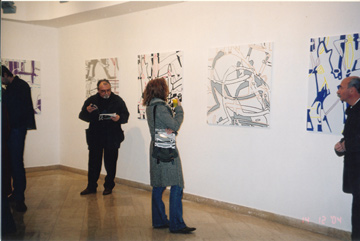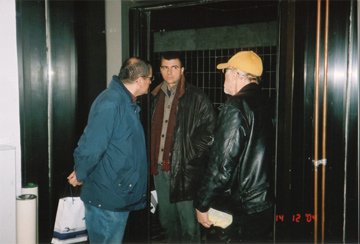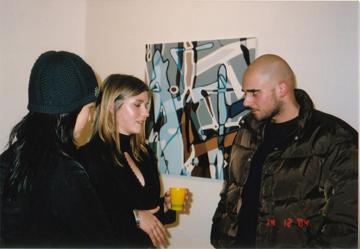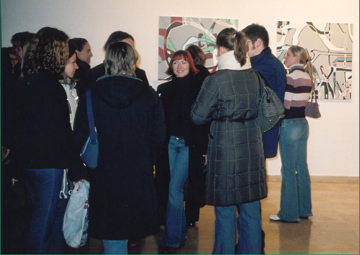In the recent Croatian visual arts there are many works that still dissipate the romantic notion of traditional media and natural materials in plastic arts that – with all their values and paleotechnical principles – cannot disappear even in the merciless competition with the most sophisticated technological innovations since they are bearers of the important and most subtle constant: man as a creator. The human creativity is here perceived as a demystified human behavior, always noble in motives, refined in procedures, accessible in meaning, intelligible in messages, acceptable in conclusions…
 Although it is possible to find at the international scene some examples of the revalorization of the manual quality in painting, we cannot discuss the same efforts on the local scene because here the attempts of its annihilation had never been experienced.
Although it is possible to find at the international scene some examples of the revalorization of the manual quality in painting, we cannot discuss the same efforts on the local scene because here the attempts of its annihilation had never been experienced.
Already today electronics, informatics, World Wide Web and computer industry have huge roles in our lives with prospects of further development reaching terrifying proportions. Microsoft, for example, has announced that human skin will transmit not only data, but also electric energy, which means that in the future every human being on Earth will be willingly or unwillingly networked!
The art has to deal with its time, the drama of human existence as well as the conflicts and tensions and artists must never get  out of touch with the spirit of the time; they have to express their individual comment on the abundance of contemporary problems.
out of touch with the spirit of the time; they have to express their individual comment on the abundance of contemporary problems.
At her first individual show, significantly entitled “Future” - thus obviously confirming her subjective concern about our future and even its inevitability - – Diana Šimek shares attitude of many previous generations of visual artists: the artist cannot change anything important in the world that surrounds him and therefore there is nothing else but to build his or hers own world of art.
Although she is a young painter, Diana has inherited the attitude established in the Sixties of the previous century (embodied in, for example, neoconstructivist concept of computer art) that the art  in its development should be integrated - using all available tools - with the contemporary scientific and technological/technical achievements and with the artist’s own statement about the world in which he or she is creating. It seems as if Diana is asking herself why the electronic potential, penetrating our lives as an everyday tool in mass production, shouldn’t be used - without discrimination - in the production of various plastic organisms, since the computers have been introduced in the usual, everyday media practice and have become, long time ago, the element of the postmodern environment.
in its development should be integrated - using all available tools - with the contemporary scientific and technological/technical achievements and with the artist’s own statement about the world in which he or she is creating. It seems as if Diana is asking herself why the electronic potential, penetrating our lives as an everyday tool in mass production, shouldn’t be used - without discrimination - in the production of various plastic organisms, since the computers have been introduced in the usual, everyday media practice and have become, long time ago, the element of the postmodern environment.
The integration of human thought with the possibilities of the machine was achieved, thanks to the available programs, in the cycle of paintings “Future”. The tool she used is the computer: an electronic device, extraordinarily .jpg) pliable and useful for the processing of, as in this case, visual information and logical operations in further development. The computer generated visual structures were not transformed into painting by high quality laser printers or other sophisticated tools for reproduction, but with the use of traditional painting tools - acrylic on canvas.
pliable and useful for the processing of, as in this case, visual information and logical operations in further development. The computer generated visual structures were not transformed into painting by high quality laser printers or other sophisticated tools for reproduction, but with the use of traditional painting tools - acrylic on canvas.
In the preliminary situation, in - pathetically speaking - the search for the idea itself, Diana doesn’t count so much on her own imagination, as on the computer’s “offer”. She inserts her own sketches into the computer programs and checks out the drawings that the electronic device produces after the digital processing and then she accepts the drawing that she finds inspiring, both in its idea and visual quality. The eye stops only when the composition of the drawing makes sense to the artist. The  drawing passes to the artist’s hands and goes through other adequate computer processing to further and by now - based on the artist’s individual plastic intuition - completely conscious mechanical treatment, processing and filtering. The computer still has a crucial role in the process, because it is a great tool that makes possible processing of drawing variations, quick placing and distribution of drawing elements, their positions, plastic structures, constellations, directions and very sensitive motion and then also the equally quick change of coloristic correlations, colors and shades of the obtained forms.
drawing passes to the artist’s hands and goes through other adequate computer processing to further and by now - based on the artist’s individual plastic intuition - completely conscious mechanical treatment, processing and filtering. The computer still has a crucial role in the process, because it is a great tool that makes possible processing of drawing variations, quick placing and distribution of drawing elements, their positions, plastic structures, constellations, directions and very sensitive motion and then also the equally quick change of coloristic correlations, colors and shades of the obtained forms.
When the artist is satisfied with the pattern she is going to use for her painting elaborations, the sketch passes from the computer onto the paper on which Diana copies it and later she transfers its magnified variation onto the canvas. From that point everything is in the hands of the artist’s talent, her feeling for the composition, rhythmic and coloristic elaboration, sensual and emotional complements...
The forms from Diana’s drawings are .jpg) most easily compared to the reduced figures taken from the photographs and the painter realizes them without the surplus forming of color in order to avoid the illusion of space and by that also the illusion of reality. Connecting various elements and correlations of colors hence, creates the space of the painting.
most easily compared to the reduced figures taken from the photographs and the painter realizes them without the surplus forming of color in order to avoid the illusion of space and by that also the illusion of reality. Connecting various elements and correlations of colors hence, creates the space of the painting.
Simultaneously the paintings from the cycle “Future” are proofs of the colorist sensation, significant for the contemporary time. As is known for a long time, in painting every period establishes and supports its own values, so that colorism, sensation and role of the color were accepted in different ways. Since Rembrandt’s times up to the late 19th century the greatest value of painting had been depleted in the relations of chiaroscuro. We perceive Gerhard Richter as the most prominent colorist of the second half of the 20th century because his paintings most convincingly confirm the values, beauty, .jpg) fullness and lusciousness of color itself and, above all, embody to the utmost the colorism of their time. According to Richter’s own admission, the fascination with colors characteristic for the capitalist world has been immanent to his colorism ever since the moment in which he moved from the East to West Germany. That is why his colorism at the same time presents the reflection of the corpus of problems that our consumerist society confronts while plunging always deeper into the consumption. At the times of the overwhelming consumption and crucial importance and role of the advertisement - in which process the neon signs have been hugely supporting the visual identity of our environment (there are, of course, more recent examples of even more aggressive advertising) – we have been living in a different world that has been, figuratively speaking, bathed in the profuse blaze and interacting blending of colorful neon lights.
fullness and lusciousness of color itself and, above all, embody to the utmost the colorism of their time. According to Richter’s own admission, the fascination with colors characteristic for the capitalist world has been immanent to his colorism ever since the moment in which he moved from the East to West Germany. That is why his colorism at the same time presents the reflection of the corpus of problems that our consumerist society confronts while plunging always deeper into the consumption. At the times of the overwhelming consumption and crucial importance and role of the advertisement - in which process the neon signs have been hugely supporting the visual identity of our environment (there are, of course, more recent examples of even more aggressive advertising) – we have been living in a different world that has been, figuratively speaking, bathed in the profuse blaze and interacting blending of colorful neon lights.
The paintings from the cycle “Future” are Diana’s projection of the color sensation of her times - the 21st century. The backgrounds of her paintings are mostly filled with gray that symbolizes her mild pessimism regarding the future of the world as well as the grayness of the electronics and everything else - like industry, waste, smoke, smog...- that occupies always more polluted environment where colors that keep disappearing from the nature are replaced with the artificial, grayish and fluorescent glittering.
In its complete picturesqueness “Future” presents the painting charged with slightly pessimistic expression about the uncertain future of the world we live in, but - if we consider the formative characteristics and principles of form - it is also the painting of optimistic projection, it is the confirmation of the painting practice, vitality and unquestionable growth.
Ivica Župan